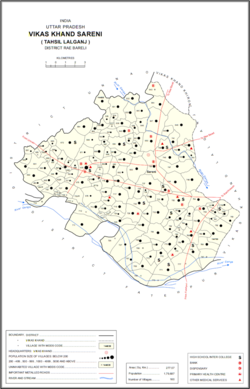Lakhangaon, Raebareli
Lakhangaon
Lakhangāon | |
|---|---|
Village | |
 Map showing Lakhangaon (#755) in Sareni CD block | |
 Lakhangaon Location in Uttar Pradesh, India | |
| Coordinates: 26°06′26″N 80°52′32″E / 26.107256°N 80.875652°ECoordinates: 26°06′26″N 80°52′32″E / 26.107256°N 80.875652°E[1] | |
| Country | |
| State | Uttar Pradesh |
| District | Raebareli |
| Area | |
| • Total | 1.383 km2 (0.534 sq mi) |
| Population (2011)[2] | |
| • Total | 1,233 |
| • Density | 890/km2 (2,300/sq mi) |
| Languages | |
| • Official | Hindi |
| Time zone | UTC+5:30 (IST) |
| Vehicle registration | UP-35 |
Lakhangaon is a village in Sareni block of Rae Bareli district, Uttar Pradesh, India.[2] As of 2011, it has a population of 1,233 people, in 210 households.[2] It has no healthcare facilities and hosts both a weekly haat and a permanent market.[2] It belongs to the nyaya panchayat of Malkegaon.[3]
The 1951 census recorded Lakhangaon (as "Lakhan Gaon") as comprising 2 hamlets, with a total population of 490 people (230 male and 260 female), in 88 households and 71 physical houses.[4] The area of the village was given as 323 acres.[4] 63 residents were literate, 53 male and 10 female.[4] The village was listed as belonging to the pargana of Sareni and the thana of Sareni.[4]
The 1961 census recorded Lakhangaon as comprising 3 hamlets, with a total population of 486 people (219 male and 267 female), in 94 households and 74 physical houses.[5] The area of the village was given as 323 acres.[5]
The 1981 census recorded Lakhangaon as having a population of 687 people, in 126 households, and having an area of 138.41 hectares.[6] The main staple foods were given as wheat and rice.[6]
The 1991 census recorded Lakhangaon (as "Lakhan Gaon") as having a total population of 658 people (341 male and 317 female), in 155 households and 155 physical houses.[3] The area of the village was listed as 139 hectares.[3] Members of the 0-6 age group numbered 94, or 14% of the total; this group was 53% male (50) and 47% female (44).[3] Members of scheduled castes made up 27% of the village's population, while no members of scheduled tribes were recorded.[3] The literacy rate of the village was 19% (103 men and 23 women).[3] 173 people were classified as main workers (171 men and 2 women), while 64 people were classified as marginal workers (2 men and 62 women); the remaining 421 residents were non-workers.[3] The breakdown of main workers by employment category was as follows: 112 cultivators (i.e. people who owned or leased their own land); 39 agricultural labourers (i.e. people who worked someone else's land in return for payment); 0 workers in livestock, forestry, fishing, hunting, plantations, orchards, etc.; 0 in mining and quarrying; 6 household industry workers; 1 worker employed in other manufacturing, processing, service, and repair roles; 0 construction workers; 3 employed in trade and commerce; 0 employed in transport, storage, and communications; and 12 in other services.[3]
References[]
- ^ "Geonames Search". Do a radial search using these coordinates here.
- ^ a b c d e "Census of India 2011: Uttar Pradesh District Census Handbook - Rae Bareli, Part A (Village and Town Directory)" (PDF). Census 2011 India. pp. 262–87. Retrieved 23 October 2021.
- ^ a b c d e f g h Census 1991 Series-25 Uttar Pradesh Part-XII B Village & Townwise Primary Census Abstract District Census Handbook District Raebareli (PDF). 1992. pp. xxiv–xxviii, 178–9. Retrieved 23 October 2021.
- ^ a b c d Census of India, 1951: District Census Handbook Uttar Pradesh (42 - Rae Bareli District) (PDF). Allahabad. 1955. pp. 112–3. Retrieved 23 October 2021.
- ^ a b Census 1961: District Census Handbook, Uttar Pradesh (39 - Raebareli District) (PDF). Lucknow. 1965. pp. lxxiv-lxxv of section "Dalmau Tahsil". Retrieved 23 October 2021.
- ^ a b Census 1981 Uttar Pradesh: District Census Handbook Part XIII-A: Village & Town Directory, District Rae Bareli (PDF). 1982. pp. 146–7. Retrieved 23 October 2021.
- Villages in Raebareli district
- Lucknow division geography stubs
